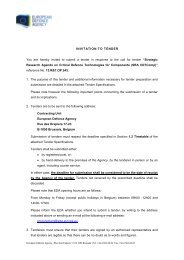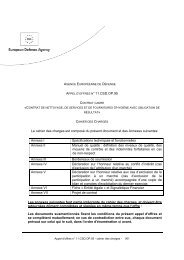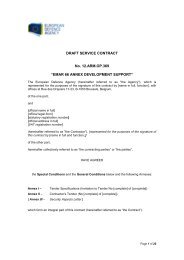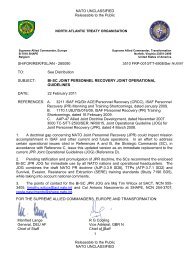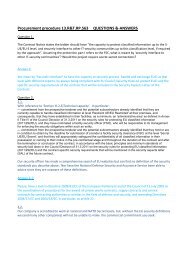capability development plan - European Defence Agency - Europa
capability development plan - European Defence Agency - Europa
capability development plan - European Defence Agency - Europa
Create successful ePaper yourself
Turn your PDF publications into a flip-book with our unique Google optimized e-Paper software.
STRATEGIC DRIVERS<br />
8. In the Middle East (representing half of the world's oil production by 2025) the US is likely to<br />
safeguard its interests, particularly the region's energy resources. If national and collective<br />
diversification policies turn out to be unsuccessful the competition for these resources will become even<br />
more intense.<br />
9. The extended use of nuclear energy will increase the risk of nuclear accident and potential terrorist<br />
type of attacks against nuclear power <strong>plan</strong>ts. If proliferation regimes do not strictly enforce their own<br />
regulations it may allow vindictive parties’ access to nuclear material.<br />
10. Bio-energy production may become a contradictory issue. Bio-energy production requires cultivated<br />
land that is scarce in many developing regions. Conflicting interests of bio-energy producers and those<br />
who need food is likely to lead tensions and humanitarian tragedies.<br />
© sxc.hu<br />
37<br />
POSSIBLE CONSEQUENCES FOR DEFENCE<br />
11. Concepts – A substantial rise in energy prices may increase pressure to cut down defence<br />
spending. Consequently, this may lead to smaller armed forces, reduced ability to launch cutting edge<br />
equipment replacement programmes and undertake defence research.<br />
12. The ability to secure and maintain free access to areas of strategic interest will remain vital.<br />
However, in the face of political, human and financial risks of intervention developed states may be<br />
increasingly reluctant to expend resources and manpower on failed states and ungoverned space.<br />
13. Most of the world's trade, in particular energy transports, will continue to transit by sea. The Straits<br />
of Hormuz, the Suez Canal and the Straits of Malacca will remain maritime choke points of strategic<br />
importance. International cooperation, including the ability to deploy and sustain maritime power<br />
worldwide is likely to be of strategic importance.<br />
14. Political instability in oil production regions is likely to force developed countries to seek political<br />
and/or other solutions to increase stability. These solutions may include military intervention. In some<br />
cases, it may be required to secure routes of supply at strategic distances (mainly at sea) and/or to<br />
secure the integrity of exploitation spots.<br />
15. Equipment - The need for reducing both fuel consumption and carbon dioxide emissions will<br />
translate into binding regulations that armed forces are likely to have to comply with. Also, alternative<br />
liquid fuel and fuel cell solutions are likely to be imposed on defence equipment. This will necessitate<br />
equipment retrofit and will influence the <strong>development</strong> of new military capabilities. Cost will be an issue.<br />
16. Modern armed warfare (Network Concept) in the future will increase demand for stable and<br />
sufficient power sources going down to the individual level. This may increase logistics burden in the<br />
nearer term.<br />
17. The <strong>development</strong> and fielding of novel power sources and propulsion systems will improve<br />
performance (in particular longer endurance) and mobility of military systems (in particular weight &<br />
volume) and may reduce the logistic burden.<br />
ECONOMY<br />
MAJOR TRENDS<br />
1. The world economy will continue to maintain a sustained growth over the 2005-2025 timeframe,<br />
sustained by globalisation. The average income per inhabitant will increase. Simultaneously, this<br />
increase in global wealth will be accompanied by a growing inequality in its distribution and size (at<br />
internal and international levels).<br />
2. The standard of living in the new <strong>European</strong> Member States is likely to converge with the level<br />
prevailing in Western Europe. The increase in global wealth will be accompanied by an upward trend<br />
in the level of inequalities. The standard of living in sub-Saharan Africa will have the tendency to<br />
decline due to unresolved structural difficulties.<br />
FUTURE TRENDS FROM THE CAPABILITY DEVELOPMENT PLAN





